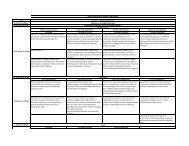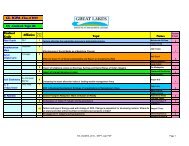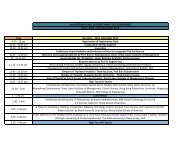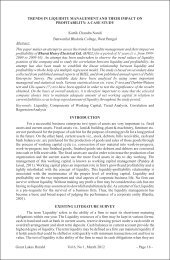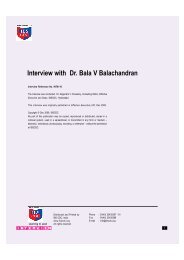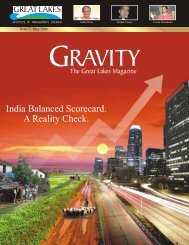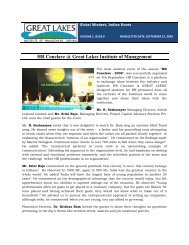Comparative Analysis of Indian Stock Market with ... - Great Lakes
Comparative Analysis of Indian Stock Market with ... - Great Lakes
Comparative Analysis of Indian Stock Market with ... - Great Lakes
You also want an ePaper? Increase the reach of your titles
YUMPU automatically turns print PDFs into web optimized ePapers that Google loves.
To sum up:<br />
69<br />
Finally, we can sum up <strong>with</strong> the following observations:<br />
• The markets have indeed started to integrate and <strong>Indian</strong> market is no exception<br />
especially after 2002-03.<br />
• The regulatory authorities must remove any ambiguity that may be existing when<br />
compared to the regulations <strong>of</strong> other exchanges before they can actually make the<br />
grade.<br />
• Lastly, although it has to be accepted that the market is evolving but the <strong>Indian</strong> system<br />
has already attained the minimum level <strong>of</strong> robustness and efficiency to be counted<br />
among the best in the world and stand equipped to attain higher sophistication as well<br />
as heightened activities. As for the existence <strong>of</strong> any signals or patterns among the stock<br />
exchanges, it can safely be said that the markets do react to global cues and any<br />
happening in the global scenario be it macro economic or country specific (foreign<br />
trade channel) affect the various markets.<br />
In short, the <strong>Indian</strong> exchanges are ready to make the transition should the government<br />
decides to further relax the regulations and open up. The financial sector as a whole, <strong>with</strong> the<br />
stock markets as its indicator, has indeed come a long way and are ready for the next level<br />
<strong>with</strong> regards to efficient trading and variety in the instruments traded.<br />
Thus this study validates the popular belief that the markets in general and <strong>Indian</strong> market<br />
in particular is more integrated <strong>with</strong> other global exchanges from 2002-03 onwards. This can<br />
very well be seen since the South Asian crisis <strong>of</strong> the mid- late nineties barely affected us<br />
particularly because we were insulated due to government policies and was just making the<br />
transition. However, in the later time periods, the influence <strong>of</strong> other stock markets increased<br />
on our BSE or NSE, but at a very low almost insignificant level. At the time <strong>of</strong> 9/11 incident,<br />
NYSE had started to exert its influence on us but at lower levels and hence the economic<br />
downturn did not impact for long. The increased trend <strong>of</strong> <strong>Indian</strong> companies going for ADR and<br />
GDR issues has also contributed as a channel for information transfer between the exchanges<br />
where the particular company is listed. This has not only facilitated the integration process but<br />
also increased the sensitivity <strong>of</strong> the home country’s stock exchange to the movements <strong>of</strong><br />
various other exchanges especially where the home company is listed. As for the existence <strong>of</strong><br />
any signals or patterns among the stock exchanges, it can safely be said that the markets do<br />
react to global cues and any happening in the global scenario be it macro economic or country<br />
specific (foreign trade channel) affect the various markets.<br />
©<strong>Great</strong> <strong>Lakes</strong> Herald – April 2007 Volume 1, Issue 1 by <strong>Great</strong> <strong>Lakes</strong> Institute <strong>of</strong> Management, Chennai






